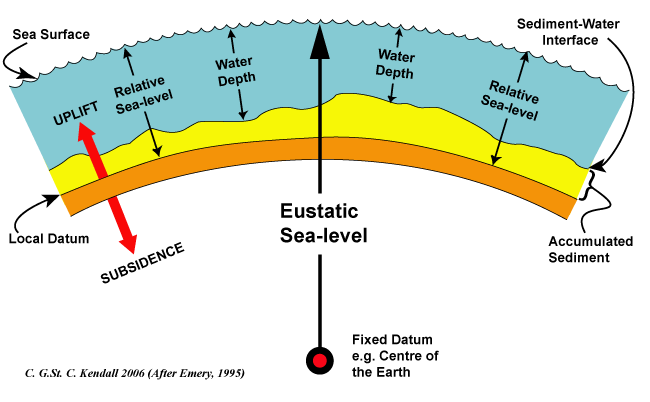eustasy
relative sea level |

This is the surface to which sediment accumulation fills up to or erodes down to and is related to continental erosion. It is a dynamic surface controlled by erosion, sediment deposition, tectonic movement and eustasy.

Commonly base level is equated to relative sea level position, but it can be related to the water surface of lakes and/or local equilibrium surfaces associated with river systems (Wheeler, 1964). Unless indicated otherwise on this web site base level will be equated to relative sea level position, and so the base level of depositional settings is thus controlled by a combination of eustasy and tectonic movement.

COMMENT: You should remember this is an oversimplification but for carbonates this is a critical consideration.
On lithoclastic shelves, the base level for sediment accumulation tends to be the equilibrium profile of the shelf (Swift and Thorne, 1991) and represents a balance between sediment input and fluid motion. This shelf equilibrium profile of Swift and Thorne (1991) is a conceptual surface of dynamic equilibrium that partially modifies the marine profile of equilibrium concept of Dietz (1963). Dietz (1963) considered the marine profile of equilibrium as a corollary of the wave-base concept; defined by Rich (1951) as the greatest depth to which the bottom is stirred by waves during storms. The "shelf equilibrium profile" of Swift and Thorne (1991) embodies the concept of base level as it was proposed by Wheeler (1964).
In terrigenous dominated systems, the shelf dispersal system produces a textural gradient and facies differentiation, and results in a seawards shift of the locus of deposition to a slope dominated by gravity processes (Swift and Thorne, 1991). The ultimate balance of the power of fluid motion on the shelf can be visualized in terms of hydraulic competence: the ability of water to transport detritus in terms of particle size rather than quantity, measured as the diameter of the largest particle transported.
Fluid power depends on wave-, storm- and tidal energy and their induced currents. These large-scale dispersal mechanisms depend on the episodic nature of bed load transport across the shelf occurs during short periods of intensive movement followed by long periods of quiescence (Swift et al., 1971).
Although on wave-dominated shelves, fair-weather and storm-wave base are the keys that are generally used to separate different zones on the shelf, fluid power depends on the spectrum of wave amplitudes that operate during both fair-weather and storm conditions. This spectrum may be notably different in distinct oceanic settings.
Sediments aggrade until they reach the equilibrium profile, decreasing the subsequent rates of net deposition, while there is sufficient fluid power to move them down-shelf and offshore in response to intermittent storm- and tidal currents.
Elevation of the equilibrium profile results from increasing sediment input, but also from decreasing hydraulic energy. The deepening of the shelf equilibrium profile results from increased fluid power, but also from a decreasing sediment supply. Pomar and Tropeano (2001) document how important base level high-resolution fluctuations are in controlling facies distribution and bedding patterns and enable their seperation into high-frequency simple sequences and parasequences in a lithoclastic, wave dominated system. The exceptional record of these simple sequences are parasequences that were the result of tectonically-induced continuous subsidence that allowed complete preservation. Later tectonically induced uplift and incision by rivers produced magnificent outcrops that allow 3D observation of these features.
In carbonates, however, greater diversity of depositional profiles and distribution of facies-belts than in lithoclastic systems, reflects major differences in genetic factors. Because hydraulic energy depends on oceanographic conditions on the shelf, differences between carbonate and lithoclastic systems should relate to differences in sediment input. In a stable sea-level regime, variability of depositional profiles among carbonate platforms can be considered as the balance between the different types of sediments being produced, the loci of sediment production and the hydraulic energy.
Pomar (2001 a, b) demonstrated how the base level for carbonate sediment to accumulate (accommodation) depends on the type and locus of carbonate sediment being produced, and how the type, efficiency and area of the carbonate factory are influenced by sea-level changes and sea-floor morphology.
References
Catuneanu,O., 2002, Sequence Stratigraphy of clastic systems: concepts, merits, and pitfalls Journal of African Earth Sciences, Volume 35, Issue 1, Pages 1-43
Dietz, R.S. (1963), Wave-base, marine profile of equilibrium, and wave-built terraces: A critical appraisal. Geological Society of America Bulletin, 74, 971-990.
Pomar, L. (2001 a), Ecological control of sedimentary Accommodation: evolution from a Carbonate ramp to rimmed shelf, Upper Miocene, Balearic Islands. Palaeogeography, Palaeoclimatology, Palaeoecology, 175:249-272.
Pomar, L. (2001 b), Types of Carbonate platforms, a genetic approach. Basin Research, 13: 313-334.
Pomar, L., & Tropeano, M., (2001), The "Calcarenite di Gravina" Fm. In Matera (Southern Italy): new insights for large-scale cross-Bedded sandbodies encased in offshore deposits. American Association of Petroleum Geologists Bulletin, 84: 661-689.
Rich, J.L. (1951), Three critical environments of deposition and criteria for recognition of rocks deposited in each of them. Geological Society of America Bulletin, 62, 1-20.
Swift, D.J.P., Stanley, D.J. & Curay, J.R. (1971), Relict sediments on continental shelves: a reconsideration., Journal of Geology, 79, 322-346.
Swift, D.J.P. & Thorne, J.A. (1991), Sedimentation on continental margins, I: a general model for shelf sedimentation. In: Shelf sand and sandstone bodies (Ed. by D.J.P. Swift, G.F. Oertel, R.W. Tillman and J.A. Thorne), International Association of Sedimentologists Special Publication, No. 14, 3-31.
Wheeler, H.E. (1964), Base level, lithosphere surface, and time-Stratigraphy. Geological Society of America Bulletin, 75, 599-610.
|